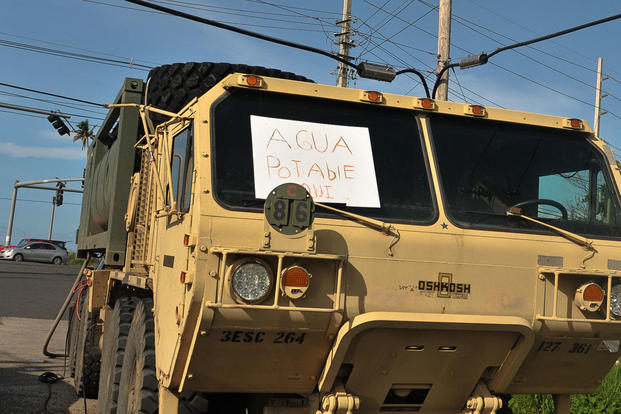The death toll in Puerto Rico from the immediate impact of Hurricane Maria and its aftermath rose to 48 over the weekend, amid efforts by the military to ease the strain on the island's overburdened health care system.
The Army was setting up two field hospitals to support medical assistance provided by the hospital ship USNS Comfort.
Rotary aircraft from the Army's 1st Armored Division's Combat Aviation Brigade and units of the 101st Airborne Division brought food and water to towns in the island's mountainous interior.
Daily missions are being flown out of the former Roosevelt Roads Naval Air Station in Ceiba at the eastern end of the island. The base was closed in 2004 but is being used as a staging area by units of the Army, Air Force, Marines and Navy, U.S. Northern Command said in a statement.
Related content:
- Trump Warns Military, FEMA Could Be Pulled From Puerto Rico
- Hospital Ship Takes on Critical Patients in Puerto Rico Crisis
- Military Response in Puerto Rico Delays Deployments to Afghanistan
In addition, numerous charitable organizations are arranging private flights off the island to Florida for the elderly and those in need of constant care, such as dialysis patients.
By Sunday, the Comfort had treated more than 100 patients, many of them critical. The ship, which has about 250 hospital beds, is currently operating off Aguadilla in the western area of Puerto Rico, NorthCom said.
Navy Cmdr. John Devlin, an emergency physician aboard the Comfort, told WAVY-TV of Norfolk, Virginia, that the doctors and nurses in Puerto Rico are capable of meeting the medical needs of patients under normal circumstances, but "there are just a lot more of them [patients]" in the aftermath of the hurricane.
"So we are here to take on the patients who are overwhelming the system," he said.
Through Saturday, the military had delivered more than 7.8 million meals, 6.4 million liters of water, and 271 generators for distribution throughout the island, NorthCom said.
As the recovery proceeds, President Donald Trump appeared to back off his suggestion last week that relief efforts by the military and the Federal Emergency Management Agency could end soon for Puerto Rico's 3.4 million U.S. citizens.
In a Tweet last Thursday, he said, "We cannot keep FEMA, the Military & the First Responders, who have been amazing (under the most difficult circumstances) in P.R. forever!"
He also suggested that Puerto Rico's problems with infrastructure and debt are the long-term result of poor governance and management by island officials.
Late Friday, Trump told reporters, "I love the people of Puerto Rico, and we're going to help them."
He added, "They have a lot of problems. We're going to help them straighten it out."
The entire power grid was knocked out when Hurricane Maria hit as a Category 4 storm on Sept. 20. As of Sunday, 85 percent of Puerto Ricans were still without electricity, the Defense Department said in a statement.
Forty-two percent of cell phone customers on the island lacked service, and 36 percent lacked access to potable water.
In a Saturday news briefing, Puerto Rican Gov. Ricardo Rossello predicted power could be restored for all but five percent of Puerto Ricans before Christmas.
"These are aggressive goals," Rossello said, but the plan is to have half the island back on the grid by mid-November and to have power restored for 95 percent by mid-December.
The U.S. Army Corps of Engineers (USACE) is working with local authorities on power restoration.
Marines of the 26th Marine Expeditionary Unit, based at Camp Lejeune, North Carolina, have been joined by members of the 24th Marine Expeditionary unit, also based at Lejeune, in efforts to open roads to isolated areas with the help of Navy Seabees from Amphibious Construction Battalion 2 and Construction Battalion Maintenance Unit 202.
-- Richard Sisk can be reached at Richard.Sisk@Military.com.































